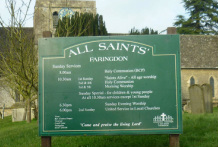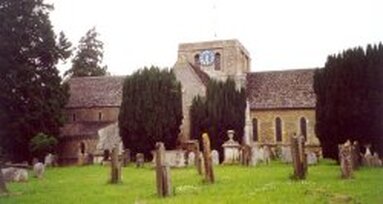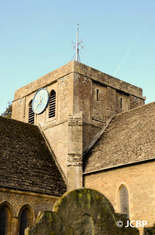All Saints Church, Faringdon
South Door

On the south wall of the transept is encased an iron cannon ball from the Civil War bombardments. Up inside the "richly shafted" tower crossing [c 12] are eight heads; odd details are due to repairs after its steeple was felled in 1645. The early c 13 chancel, with c 19 glass in all its lancet windows, contains pre-Reformation survivals: the piscina with trefoil arches; and the later sedilia.
Among the tomb slabs in the floor is that to Sir Marmaduke Rawdon, garrison commander in 1645. A broad arch leads into the north chapel. The earliest monument, in the style of Grinling Gibbons, is for Henry Purefoy [+1686] with two weeping putti, cherubs' heads and vase at the top. Three monuments commemorate members of the Pye family, who then owned Faringdon House. The white marble and black columns of the one to Jane [+1706] has putti about "an open curly pediment" topped by an urn. A plainer one, of grey marble, is for Anna [+1729]. Henry [+ 1749], husband of the two preceding, is commemorated by an obelisk faced with an oval portrait of his young son.
The building stands in a church yard, filled with tombstones and tombchests, the last dated 1982, after the cemetery in Coach Lane was opened. Many inscriptions have been eroded by the weather of centuries, some to the point of illegibility. On the exterior of the east wall of the Chancel is a monument inset with the cannon ball said to have struck down the naval officer commemorated. A list of these tombs can be consulted in the Faringdon library.
© Gerald Taylor
Pevsner, Berkshire, p 139. Surveyed by NADFAS in 19..
Among the tomb slabs in the floor is that to Sir Marmaduke Rawdon, garrison commander in 1645. A broad arch leads into the north chapel. The earliest monument, in the style of Grinling Gibbons, is for Henry Purefoy [+1686] with two weeping putti, cherubs' heads and vase at the top. Three monuments commemorate members of the Pye family, who then owned Faringdon House. The white marble and black columns of the one to Jane [+1706] has putti about "an open curly pediment" topped by an urn. A plainer one, of grey marble, is for Anna [+1729]. Henry [+ 1749], husband of the two preceding, is commemorated by an obelisk faced with an oval portrait of his young son.
The building stands in a church yard, filled with tombstones and tombchests, the last dated 1982, after the cemetery in Coach Lane was opened. Many inscriptions have been eroded by the weather of centuries, some to the point of illegibility. On the exterior of the east wall of the Chancel is a monument inset with the cannon ball said to have struck down the naval officer commemorated. A list of these tombs can be consulted in the Faringdon library.
© Gerald Taylor
Pevsner, Berkshire, p 139. Surveyed by NADFAS in 19..
The Bells

All Saints Notice Board
The dedication of the Bells, Clock and Chimes was carried out by the Right Reverend Bishop Shaw, DD on Thursday 9th December, 1926 at All Saints Church.
The Tenor bell sounds every hour between 0800 and 2100, and a carillon plays at 9am,noon, 3pm, 6pm and 9pm each day.
There is a different hymn for each day of the week.
More information on www.achurchnearyou.com
All Saints Church website
The Tenor bell sounds every hour between 0800 and 2100, and a carillon plays at 9am,noon, 3pm, 6pm and 9pm each day.
There is a different hymn for each day of the week.
More information on www.achurchnearyou.com
All Saints Church website

